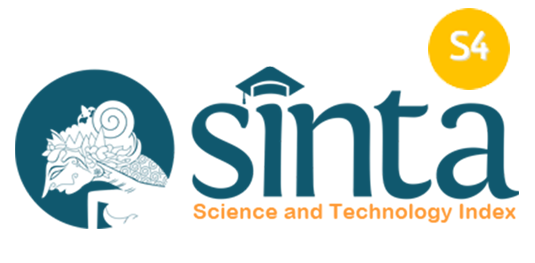Improving Critical Thinking Character Through Numeracy Literacy For Elementary School Students
Abstract
Numeracy literacy is very important for elementary school students because it provides a basis for applying mathematics in everyday life. Numeracy literacy requires students to think critically in solving problems. Moreover, elementary school is early childhood education to start getting used to thinking through research and analysis. Researchers use qualitative research in literature studies by reviewing various sources such as books, articles, modules, and final research assignments. The results of the research are that there are several ways to shape the critical thinking character of elementary school students with numeracy literacy, namely 1) using interactive learning models such as project-based learning and problem-based learning; 2) application of numeracy literacy in various classroom activities; and 3) conveying meaningful mathematical values during learning. A teacher can use these three methods optimally, provided that a teacher must also apply numeracy literacy in everyday life. So it will be easier for students to imitate and apply it.
References
Anggraini, D. M. (2023). Application of Numerical Literacy to Elementary School Students. ICIE: International Conference on Islamic Education. https://scholar.google.com/scholar?hl=id&as_sdt=0%2C5&q=Application+of+Numerical+Literacy+to+Elementary+School+Students&btnG=
Anggraini, D. M., Faizah, M., Afrida, F. N., Hanifah, N. H., & Norfika, R. (2023). Developing manipulative thing for mathematics learning. Pubs.Aip.Org, 2595. https://doi.org/10.1063/5.0123744
Arikunto, S. (2024). Pendekatan Penelitian Kualitatif: Konsep, Prosedur, Kelebihan dan Peran di Bidang Pendidikan. In Afeksi: Jurnal Penelitian dan Evaluasi Pendidikan (Vol. 5, Issue 2). Yayasan Nusantara Children of the Clouds. https://doi.org/10.59698/afeksi.v5i2.236
Elder, L., Paul, R., Elder, B. L., & Paul, R. (2016). Why We Must Transform Our Teaching Critical Thinking : Search.Proquest.ComL Elder, R PaulJournal of Developmental Education, 1994•search.Proquest.Com, 18(1), 34–35. https://search.proquest.com/openview/919546129618774927ef200f2fc3bb02/1?pq-origsite=gscholar&cbl=2030483
Etherington, M. B. (2011). Investigative Primary Science: A Problem-based Learning Approach. Australian Journal of Teacher Education, 36(9). https://doi.org/10.14221/ajte.2011v36n9.2
Geiger, V., Goos, M., & Forgasz, H. (2015). A rich interpretation of numeracy for the 21st century: a survey of the state of the field. ZDM - International Journal on Mathematics Education, 47(4), 531–548. https://doi.org/10.1007/s11858-015-0708-1
Jonassen, D. H., & Hung, W. (2008). Problem Based Learning. Interdisciplinary Journal of Problem-Based Learning, 2(2). https://doi.org/10.7771/1541-5015.1080
JS Miller. (2004). Problem-based learning in organizational behavior class: Solving students’ real problems. Journal of Management Education, 28(5), 578–590. https://doi.org/10.1177/1052562903257937
Khakima, L. N., Zahra, S. F. A., Marlina, L., & Abdullah, Z. (2021). Penerapan Literasi Numerasi dalam Pembelajaran Siswa MI/SD. Prosiding Seminar Nasional PGMI, 1(1), 775–791. http://proceeding.iainpekalongan.ac.id/index.php/semai-775-
Khoiriyah, A., Biologi, H. H.-J. (Jurnal P., & 2018, undefined. (2018). Problem-based learning: Creative thinking skills, problem-solving skills, and learning outcome of seventh grade students. Ejournal.Umm.Ac.IdAJ Khoiriyah, H HusamahJPBI (Jurnal Pendidikan Biologi Indonesia), 2018•ejournal.Umm.Ac.Id, 4(2), 151–160. https://doi.org/10.22219/jpbi.v4i2.5804
Kokotsaki, D., Menzies, V., & Wiggins, A. (2016). Project-based learning: A review of the literature. Improving Schools, 19(3), 267–277. https://doi.org/10.1177/1365480216659733
Krajcik, J. S., & Czerniak, C. M. (2018). Teaching science in elementary and middle school: A project-based learning approach. Teaching Science in Elementary and Middle School: A Project-Based Learning Approach, 1–359. https://doi.org/10.4324/9781315205014/TEACHING-SCIENCE-ELEMENTARY-MIDDLE-SCHOOL-JOSEPH-KRAJCIK-CHARLENE-CZERNIAK
Marhayati. (2022). Problem based learning untuk mengembangkan literasi numerasi peserta didik dan mewujudkan profil pelajar Pancasila. Repository.Uin-Malang.Ac.Id. https://doi.org/10.36655/sepren.v4i0.841
Masyhadi. (2022). Capaian Literasi, Numerasi, dan Karakter Siswa di Provinsi Jawa Tengah Tahun 2021. Https://Bbpmpjateng.Kemdikbud.Go.Id. https://bbpmpjateng.kemendikdasmen.go.id/capaian-literasi-numerasi-dan-karakter-siswa-di-provinsi-jawa-tengah-tahun-2021/
McMillan, J., & Schumacher, S. (2010). Research in education: Evidence-based inquiry. My EducationLab Series. Pearson. https://ixtheo.de/Record/1618719254
Mubarok, H., & Anggraini, D. M. (2020). Literation Skill To Improve Higher-Order Thinking Skills In Elementary School Students. Al-Bidayah: Jurnal Pendidikan Dasar Islam, 12(1), 31–42. https://doi.org/10.14421/al-bidayah.v12i1.234
Mubarok, H., Anggraini, D. M., & Charis, A. (2023). The Urgency of Critical Thinking Character for Elementry Student. Quality. https://doi.org/10.21043/quality.v11i1.20523
Nurcahyono, N. A. (2023). Peningkatan Kemampuan Literasi Dan Numerasi Melalui Model Pembelajaran. Hexagon: Jurnal Ilmu Dan Pendidikan Matematika. https://scholar.google.com/scholar?hl=id&as_sdt=0%2C5&q=Novi+Andri+Nurcahyono%2C+“Peningkatan+Kemampuan+Literasi+Dan+Numerasi+Melalui+Model+Pembelajaran%2C”+Hexagon%3A+Jurnal+Ilmu+Dan+Pendidikan+Matematika%2C+2023%2C+19–29.&btnG=
O’Donoghue, J. (2006). Assessing Numeracy. Perspectives on Adults Learning Mathematics, 14(1), 271–287. https://doi.org/10.1007/0-306-47221-x_15
Purnawanto, A. T. (2022). Perencanakan Pembelajaran Bermakna Dan Asesmen Kurikulum Merdeka. Jurnal Pedagogy, 15(1), 75–94. https://doi.org/10.63889/pedagogy.v15i1.116
Ronis, D. L. (2008). Problem-Based Learning for Math & Science: Integrating Inquiry and the Internet. In Corwin Press. Corwin Press. https://books.google.fi/books?hl=fi&lr=&id=gnX750EfDKUC&oi=fnd&pg=PR7&ots=WdvejNtIVC&sig=P6ZC43ZaLbbKF01Doe_Puaxt4EU&redir_esc=y#v=onepage&q&f=false
Sachdeva, S., & Eggen, P.-O. (2021). Learners’ Critical Thinking About Learning Mathematics. International Electronic Journal of Mathematics Education, 16(3), em0644. https://doi.org/10.29333/iejme/11003
Sarumaha, Y. A., Pratama, R., Oka, W., Saputri, D., Hofifah, R. T., Pendidikan, P. S., & Fkip, M. (2024). Penggunaan Alat Peraga Papan Peluang Matematika pada Materi Peluang Kelas VII SMPNANo ranking found for “Konstruktivisme : Jurnal Pendidikan dan Pembelajaran.” Core.Ac.Uk, 16(1), 142–151. https://doi.org/10.35457/KONSTRUK.V16I1.3437
Situmorang, R. (2022). Menumbuhkan Gerakan Literasi di Sekolah. In Badan Pengembangan dan Pembinaan Bahasa - Kemendikbudristek (p. 1). https://badanbahasa.kemdikbud.go.id/artikel-detail/734/menumbuhkan-gerakan-literasi-di-sekolah
Wilson, G., Anderson, M., Chemistry, C. L.-A., & 1999, undefined. (1999). Peer Reviewed: Instrumental Analysis at the University of Kansas: An Experiment in Problem-Based Learning.Q1Analytical Chemistry; H-Index: 343SJR: Q1 CORE: NA ABDC: NA FT50: NA 2Analytical Chemistry; H-Index: 343VHB: NA FNEGE: NA CoNRS: NA HCERE: NA CCF: NA BFI: 2 AJG: NA +. ACS PublicationsGS Wilson, MR Anderson, CE LunteAnalytical Chemistry, 1999•ACS Publications, 71(19), 677A-681A. https://doi.org/10.1021/AC990702A
Zed Mestika. (2017). Metode Penelitian Kepustakaan. Yayasan Obor Indonesia. https://books.google.co.id/books?hl=id&lr=&id=iIV8zwHnGo0C&oi=fnd&pg=PA1&dq=metode+penelitian+kepustakaan&ots=nfhi6T4aTm&sig=eXua7fLJRlU5STBoMCB5NmneTrc&redir_esc=y#v=onepage&q=metode penelitian kepustakaan&f=false

This work is licensed under a Creative Commons Attribution-ShareAlike 4.0 International License.
LETTER OF ORIGINALITY AND COPYRIGHT TRANSFER AGREEMENT
As an author of Dawuh Guru: Jurnal Pendidikan Guru MI/SD of PGMI Department of Tarbiyah Faculty, Institut Pesantren Mathali’ul Falah and Perkumpulan Dosen PGMI Indonesia, I, who sign below:
Declare that:
- My paper is authentic; my own writing and it has not been published/proposed in any other journals or publications.
- My paper is not plagiarism but my original idea/research.
- My paper is not written by other help, except by the Board of Editors and Reviewers recommendation who have been chosen by this journal.
- In my paper, there are no other writings or opinions except those referred to in the bibliography and relevant to the rule of writing in this journal.
- I do the transfer copyright of this paper to Dawuh Guru: Jurnal Pendidikan Guru MI.
- I make this assignment surely. If there are distortions and untruths in this assignment, later, I will take responsibility as the current law.

This work is licensed under Creative Commons Attribution-ShareAlike 4.0 International License.








